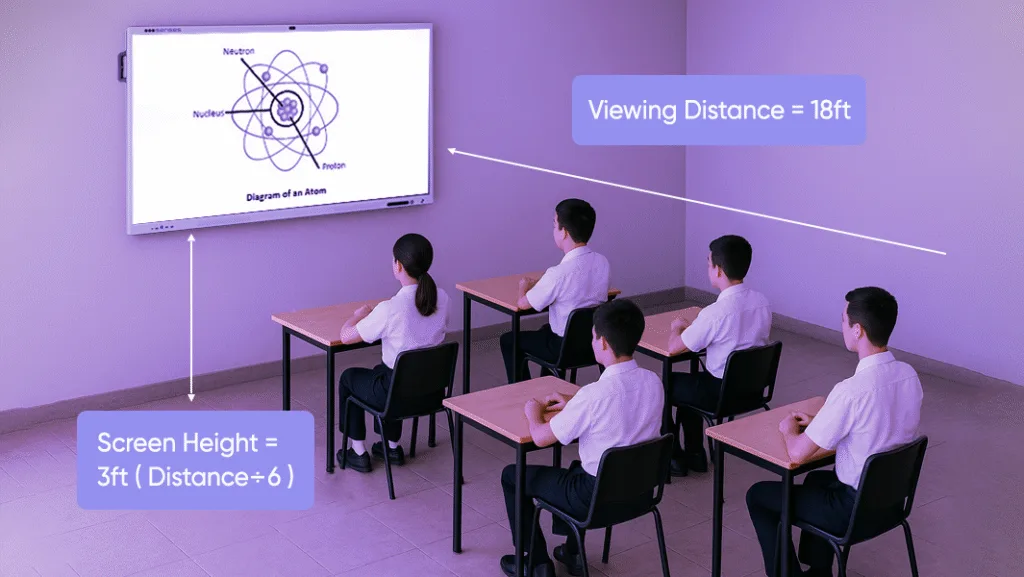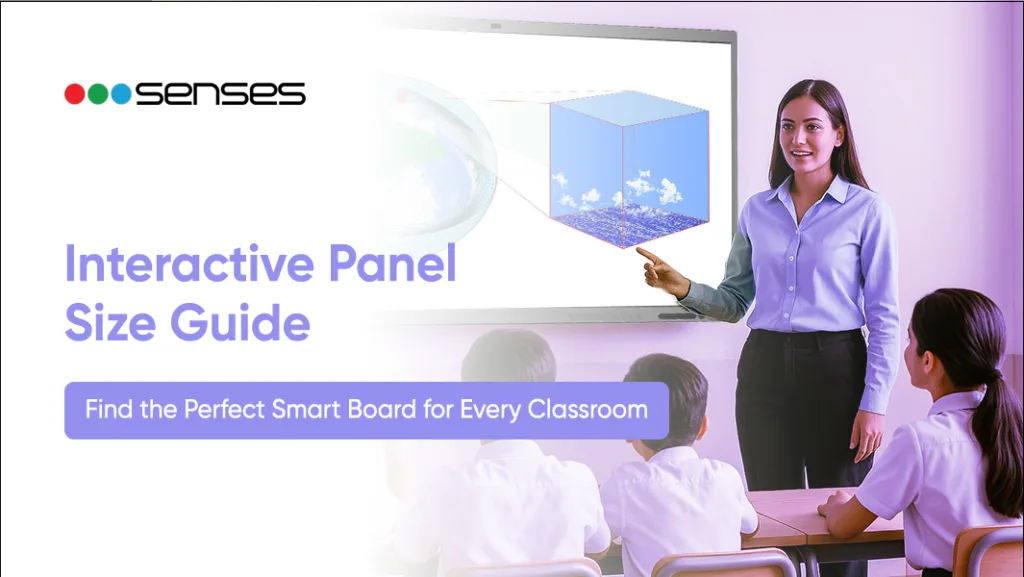For educational organizations, selecting the appropriate interactive panel size can be quite daunting. Decision-makers frequently find it difficult to decide which smartboards best suit their classroom design and teaching methodology from many options, such as 65, 75, and 86-inch.
The right-sized interactive flat panel can make all the difference, ensuring that every student enjoys clear visibility and better engagement during lessons. The size of the display has a direct impact on student-teacher engagement and learning outcomes in both massive lecture halls and small primary classrooms.
Are you unsure about the best panel for your classrooms? Get a free trial from Senses Electronics to see how the ideal smart board can improve your classroom.
Interactive Panel Sizes Explained
To accommodate various classroom kinds and educational contexts, interactive panels are available in a variety of sizes, usually ranging from 55 inches to 120 inches and beyond.
The 65-inch, 75-inch, and 86-inch interactive panels, on the other hand, are the most popular options for contemporary classrooms because they provide the ideal ratio of cost, usefulness, and visibility.
- For tiny classrooms, staff rooms, or training areas with few seats, 55-inch panels are perfect.
- For typical courses with up to 25 students, 65-inch panels are ideal since they allow everyone to comfortably observe the material.
- Wider viewing angles and better visibility make 75-inch panels an excellent choice for medium to large schools, usually with 30–40 learners.
- When content needs to be visible from the rear of a big classroom, auditorium, or conference venue, 86-inch panels are ideal.
- Large lecture halls, seminar rooms, and collaborative learning venues that require an immersive visual experience are catered to by 120-inch+ panels.
Three important considerations determine the optimal interactive display size for a classroom: the size of the space, the viewing distance, and the number of students.
Selecting a size that complies with these guidelines guarantees that interactive elements are easily accessible, text and images stay crisp, and all students remain interested throughout the class.
Common Interactive Panel Sizes and Best Use Cases
| Panel Size | Best Fit For | Recommended Audience | Ideal Use Case |
| 55″ | Small learning zones, nurseries, or staff rooms | Up to 20 learners | Great for storytelling, early learning activities, or quick team sessions |
| 65″ | Standard primary or secondary classrooms | 20–25 students | Balanced size for daily lessons, videos, and interactive exercises |
| 75″ | Mid-sized classrooms, labs, and training centres | 25–40 students | Offers excellent visibility and engagement for group learning |
| 85″ | Large classrooms or seminar spaces | 40–60 students | Perfect for presentations, detailed visuals, and hybrid learning setups |
| 98″ | Auditoriums or multipurpose halls | 60+ participants | Ensures crystal-clear visibility and immersive experiences in large gatherings |
As a rule of thumb, the larger the classroom, the bigger the screen required to maintain eye comfort and readability for every student.
For example, a 65-inch panel is ideal for a typical classroom, while an 86-inch smart board or larger guarantees that every area of a hallway is still visually accessible.
How to Choose the Right Interactive Panel Size
Choosing the ideal interactive flat panel involves more than just choosing an eye-catching display. It also entails making sure each student can see, participate, and learn efficiently.
Before you buy, take into account these five important factors:
- Classroom Dimensions
Determine the viewing distance and room size first. The screen height should be roughly equal to the longest viewing distance divided by six (Distance ÷ 6), according to the basic rule.

For instance, your screen should be around 3 feet high, or roughly equal to a 75-inch panel, if the last row of students is seated 18 feet away. This guarantees that every student, including those situated in the back, can comfortably read text and view images.
- Seating Layout
When choosing the appropriate display size, your sitting arrangement is quite important. A larger panel will work better in classrooms with several rows that reach deep into the space, but a 65-inch interactive panel can work well in smaller layouts with closer seating.
To guarantee that everyone has an unhindered view, take into account the wall mounting height as well.
- Teaching Style
Consider how educators intend to utilise the board.
- Slightly smaller panels that are easily accessible, such as 75-inch panels, are ideal for interactive, hands-on education (such as group activities or touchscreen-based learning).
- 86-inch and larger displays are more advantageous for presentation-led or hybrid sessions, when instructors show rich graphics or internet content to a large audience.
- Lighting Conditions
Screen vision can be greatly impacted by glare and ambient light. Panels with high brightness levels and anti-glare coatings should be used in rooms with plenty of windows or bright illumination. In well-lit classrooms, a larger panel also aids in maintaining clarity by guaranteeing that text and images are sharp from every aspect.
- Budget Considerations
Lastly, consider your budget and long-term requirements before making your decision. A 75-inch or 86-inch interactive screen may cost more up front, but for schools preparing to implement digital transformation across several classrooms, it offers better value, greater durability, and scalability.

Additional Tips for a Better Viewing Experience
For teachers and students to have the most visual and interactive experience, installation and setup must be done correctly after selecting the appropriate interactive panel size. Here are some professional pointers to help you do it correctly:
- Mounting Height
The interactive panel should be positioned so that the middle of it roughly corresponds to the average eye level of students who are seated. The panel can be installed a little higher in classrooms (such as labs or training areas) where students stand a lot.
All students can see and communicate comfortably without neck strain or glare due to proper height positioning.
- Optimal Positioning
Avoid placing panels too close to windows or strong light sources. The display should preferably be positioned perpendicular to the natural light in order to reduce reflections. In larger rooms, consider positioning it in the middle of the main wall for uniform visibility across all rows.
- Lighting Setup
To lessen screen glare, utilize diffused or ambient lighting rather than glaring overhead lights. Anti-glare and high-brightness displays on contemporary interactive panels, such as those from Senses, guarantee crystal-clear images even in highly illuminated classrooms.
- Cable and Power Management
Make advance plans for accessible power outlets and hidden cabling close to the installation site. This enhances long-term upkeep and safety while also maintaining a clutter-free appearance.
- Regular Maintenance and Calibration
Plan regular cleaning and calibration inspections to maintain touch accuracy and image quality. Longer life and smoother performance are provided by dust-free panels and well-maintained software.
For more insights on ensuring quality and reliability, read our detailed guide: What Are the Most Critical Quality Checks for Interactive Panels
Why Choose Senses Electronics Interactive Panels
For Indian educational institutions, Senses Electronics is a reliable partner for smart classrooms. Its interactive panels are designed to provide long-lasting performance in all instructional situations, improve learning results, and increase engagement.
Here’s why thousands of educators and IT decision-makers prefer Senses Interactive Panels:
- Designed with Indian classrooms in mind: it is optimized for a variety of board patterns, power configurations, and layouts.
- AI-powered features: include wireless screen sharing, real-time annotation, and smart touch for easy teamwork.
- Constructed with longevity in mind: anti-glare and scratch-resistant screens provide reliable performance throughout regular usage.
- Various size choices: To accommodate all classroom sizes, models measuring 65, 75, 86, and 98 inches are available.
- Full support: Senses makes the digital transition simple, from setup to training and upkeep.
Ready to bring smart learning to your classrooms? Book a demo or Request a quote
today to experience how Senses can redefine teaching and engagement for your school.
FAQs
The dimensions of your classroom and the maximum viewing distance determine the optimal size. Generally, the height of the screen should be roughly one-sixth of the distance from the screen. A 75-inch panel, for instance, is ideal for spaces where the final row is roughly eighteen feet away.
Not all the time. Larger spaces or auditoriums are better suited for 75-inch or 86-inch panels, whereas small to medium classrooms are best suited for 65-inch screens. Before making a choice, it is best to evaluate the viewing distance and seating arrangement.
Depending on the needs of the classroom, senses panels can be either on moveable platforms or mounted on the wall. For best visibility and usability, the mounting height must be appropriate, power outlets must be close by, and window or light glare must be minimized.
Larger panels are more expensive initially, but over time, their scalability, endurance, and screen quality make them economical. Sense panels are made to require little upkeep and have robust post-purchase assistance to guarantee reliable performance.

Conclusion
Optimizing visibility, student engagement, and teaching effectiveness all depend on choosing the appropriate interactive panel size. To ensure that every student has a clear and engaging experience, the optimal size is determined by the classroom’s capacity, layout, and viewing distance.
Are you prepared to identify the ideal match for your classrooms? Get a free demo from Senses Electronics right now to see how the ideal smart board can improve your classroom.

